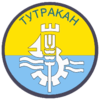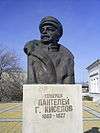Tutrakan
Tutrakan (Bulgarian: Тутракан, Romanian: Тurtucaia, Turkish: Turtukai) is a town in northeastern Bulgaria, an administrative centre of the homonymous municipality, part of Silistra Province. It is situated on the right bank of the Danube opposite the Romanian town of Oltenița (to which it was linked through a ferry but the ferry does not work anymore), in the very west of Southern Dobruja, 58 km east of Rousse and 62 km west of Silistra. As of December 2009, the town has a population of 9,476 inhabitants.[1][2][3]
Tutrakan Тутракан Тurtucaia Тurtukai | |
|---|---|
Memorial of the Battle of Tutrakan in the military cemetery of Tutrakan | |
 Coat of arms | |
 Tutrakan Location of Tutrakan | |
| Coordinates: 44°3′N 26°37′E | |
| Country | |
| Province (Oblast) | Silistra |
| Government | |
| • Mayor | Georgi Georgiev |
| Elevation | 107 m (351 ft) |
| Population (31.12.2009)[1] | |
| • City | 9,476 |
| • Urban | 16,436 |
| Time zone | UTC+2 (EET) |
| • Summer (DST) | UTC+3 (EEST) |
| Postal Code | 7600 |
| Area code(s) | 0866 |
History
The town was founded by the Ancient Romans in the end of the first half of the 1st century under the name Transmarisca. The settlement was part of the Roman military boundary in the 1st and 3rd century and reached its apogee in the 4th century, when, under the personal management of Diocletian, it was made one of the largest strongholds of the Danubian limes.
The ancient town and fortress were destroyed in the beginning of the 7th century and the modern town carrying its present name emerged in the end of the century, remaining a military centre through the Middle Ages as part of the Bulgarian Empire, which was conquered by the Ottomans in the late 14th century.
Tutrakan was liberated from Ottoman rule during the Russo-Turkish War of 1877-78 by Russians to become part of the Kingdom of Bulgaria. After the Second Balkan War, it was incorporated, along with all of Southern Dobruja, in Romania until 1940, when the pre-World War II Treaty of Craiova returned the territory to Bulgaria.
During World War I, the town, then part of Romania, was the site of the important Battle of Tutrakan during which Bulgarian and German Central Powers forces defeated the Romanian forces.
Today it remains a vibrant fishing village, and the historic Fisherman's Quarter continues to attract tourists, bicyclists, boaters and artists.
Geography
Population
| Tutrakan | |||||||||||||||
|---|---|---|---|---|---|---|---|---|---|---|---|---|---|---|---|
| Year | 1887 | 1910 | 1934 | 1946 | 1956 | 1965 | 1975 | 1985 | 1992 | 2001 | 2005 | 2009 | 2011 | 2013 | |
| Population | no data | no data | no data | 7,183 | 9,592 | 9,926 | 11,425 | 12,119 | 11,573 | 10,322 | 9,713 | 9,476 | ?? | ?? | |
| Highest number ?? in ?? | |||||||||||||||
| Sources: National Statistical Institute,[1] citypopulation.de,[2] pop-stat.mashke.org,[3] Bulgarian Academy of Sciences[4] | |||||||||||||||
Gallery
 1764 Bulgarian soldiers rest in the military cemetery in Tutrakan
1764 Bulgarian soldiers rest in the military cemetery in Tutrakan Monument of Bulgarian general Panteley Kiselov, who liberated a part of South Dobrudja during the First World War.
Monument of Bulgarian general Panteley Kiselov, who liberated a part of South Dobrudja during the First World War.
References
- (in English) Bulgarian National Statistical Institute - towns in 2009
- (in English) „WorldCityPopulation“
- „pop-stat.mashke.org“
- (in Bulgarian) Bulgarian Academy of Sciences Archived 2011-07-06 at the Wayback Machine
External links
| Wikimedia Commons has media related to Tutrakan. |
